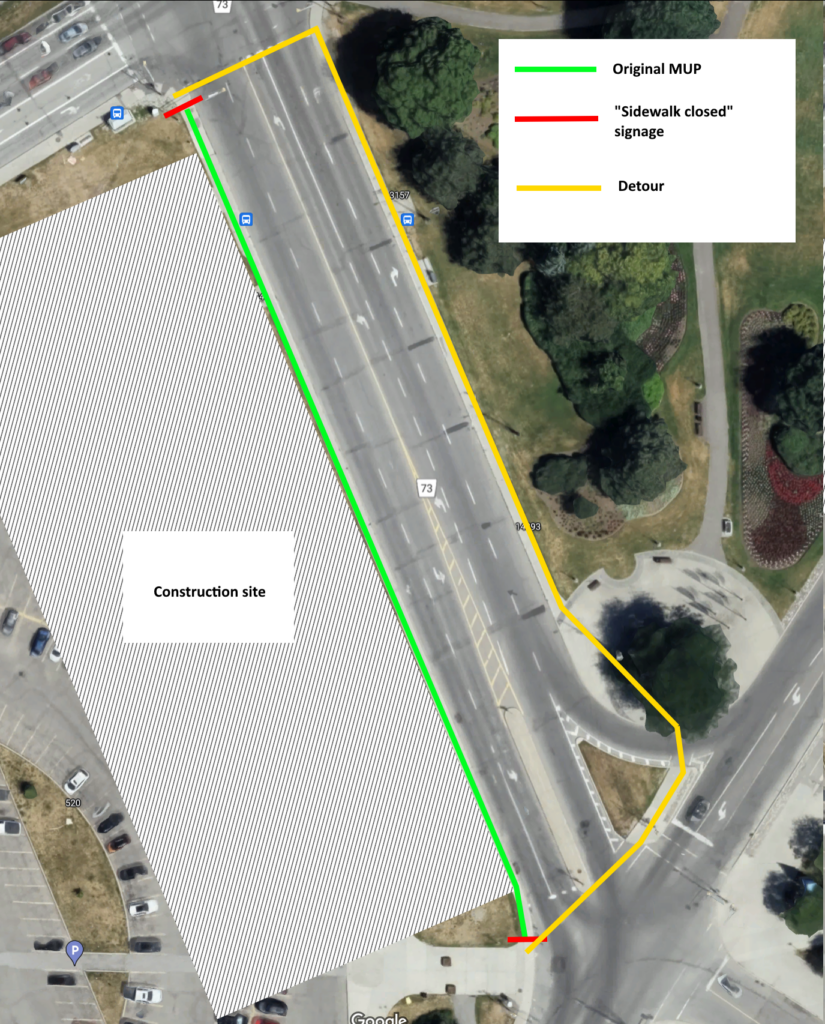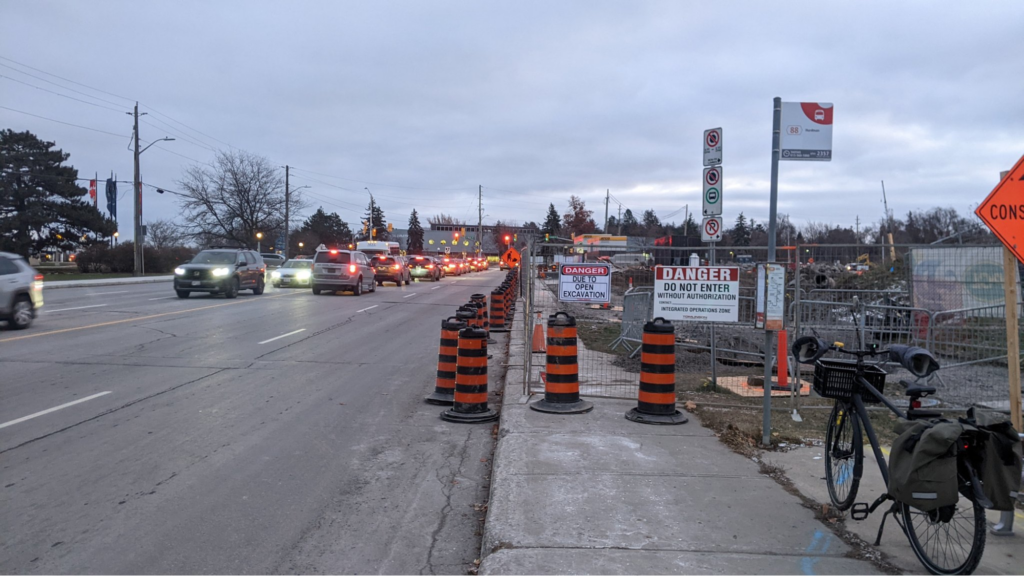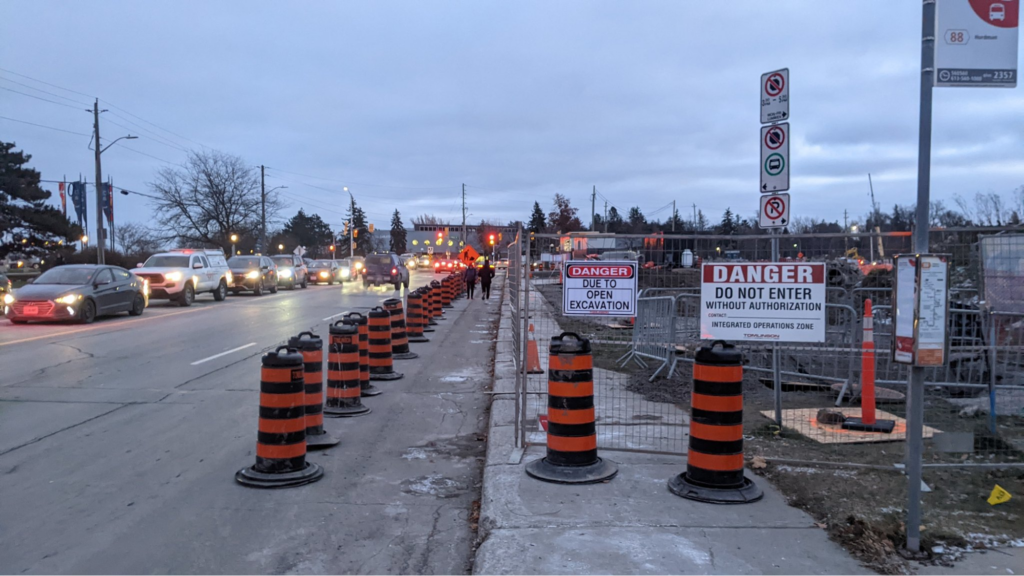Another day in Ottawa, another way the City disregards people on bikes and on foot. This time it’s the detour on Preston between Carling and Dow’s Lake around construction for the new Civic Hospital.
What’s the problem, you ask?
Put simply, since the end of November, a key biking facility along Preston St between Carling and Prince of Wales has been taken over by the contractor constructing the parking garage for the new Civic Hospital. A detour of sorts is provided, but… it leaves something to be desired.

People on bikes are asked to dismount (by the City’s beloved “walk your bike” signs) and cross Preston, then cross a slip lane, walk their bike along the East sidewalk to Carling, cross Preston again, and then resume their itinerary. This instead of a 15-second, curb-protected trip with no road crossings. We must remember that bikes are mobility devices and could be used by someone with a disability, visible or not, and that asking to dismount is therefore disabling.
We checked out the site to see how the detour was working. Of all the people biking we saw, only two used the detour; the rest biked on the road—including several against car traffic! So no, the detour isn’t working.
The contractors anticipate blocking the cycle track and sidewalk for three weeks, but we all know from experience that such blockages often last much longer, particularly when it’s winter. For example, the Trillium pathway just on the other side of Carling from this construction site was closed until recently for 13 months with no safe winter-maintained detour, after many successive delays in construction.
As people regularly biking in the area will know, this situation is no mere inconvenience. That small stretch of cycle track is a key north/south link in the winter cycling network.
If construction encroaches on a sidewalk and/or cycle track, the City is required to ensure that contractors provide a good alternative for residents. The solution to this blockage is obvious: there are five (five!) lanes devoted to car traffic here; there is no reason why one couldn’t be dedicated to people biking and walking. By not wanting to even skirt the possibility of inconveniencing car drivers, the contractor is putting Ottawans’ lives on the line and threatening accessibility.
There are no excuses for such a barter.
This choice also runs athwart of our Official Plan’s commitment to supporting non-car trips.
When the local government disregards people’s lives, it’s no surprise that some take matters into their own hands. Look at this quick and dirty version of a proper detour, done in a few minutes. Already much better, and getting used immediately!


If the City were serious about the safety of its citizens, here’s what they would do:
- Lay compacted crushed stone or asphalt connecting the cycle track to Preston St near the bus stop.
- Install pinned curbs with flex stakes cordoning off the one car lane adjacent to the construction fencing.
- On both sides, add asphalt ramps from the sidewalk level to the street level, accessible and adapted for winter maintenance equipment.
- Place pylons down the middle of the new detour to segregate people walking from those cycling/rolling with signage to tell people which side to use.

For a detour of under 1–2 weeks, or if the construction area is dynamic, traffic cones could replace pinned curbs.
Voilà! This would be a safe and practical detour suitable for a longer duration. Moreover, the bus stop could stay at its current location, and drivers would still have a right turn lane from Preston St onto Prince of Wales.
Note also that in this configuration no additional signage is required—indicative of a logical detour.
For a real-life example of a good detour, look at this one on rue Berri, in Montréal, or this one on boulevard Alexandre-Taché in Gatineau.
Paris’s guidelines for construction detours list only three acceptable options when creating such a detour. Ranking them from most preferable to least preferable, they are:
- Recreation of the existing bike lanes
- Reintegration of cyclists into the general traffic flow, upstream of the construction site, if compatible with traffic flow and speeds (i.e., only very low-traffic, traffic-calmed local streets)
- Safe and logical diversion to existing cycle paths
On the site above, only the first one is acceptable, as the speeds and flow of vehicles in the car lanes are much higher than bearable, and as there are no other alternative bike lanes around. Forcing people on bikes to dismount is only acceptable as a last recourse and for not more than a few hours.
In 2022, Bike Ottawa submitted feedback to the City’s overhauled 2009 “Cycling in Construction Zones” guidelines. We hope to hear back soon on these recommendations. And in the meantime, let’s get this detour on Preston right!
Guillaume Gaillard and William van Geest volunteer with Bike Ottawa’s Advocacy Working Group. Dave Robertson is vice president of Bike Ottawa.

